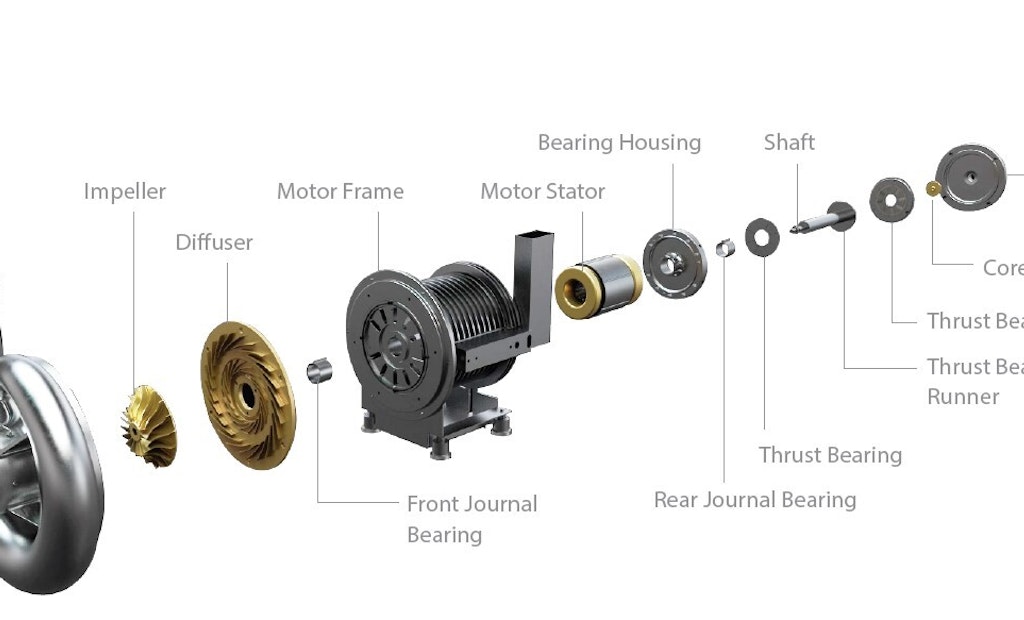Interested in Blowers?
Get Blowers articles, news and videos right in your inbox! Sign up now.
Blowers + Get AlertsThe root of air-bearing has a long history, reaching back to the patent published by an engineer of a NASA contractor in 1967. The air-bearing has been successful in the application of aerospace for air-conditioning and cabin pressurization. Since 2000, with the advance of high-speed permanent magnet synchronous motor technology, air-bearings have been applied to high-speed, gearless turbo blowers.
Due to the simplicity of the equipment and energy efficiency, the air-bearing high-speed turbo blower turned out to be a game changer in the industry. It became a solid alternative to a gear-driven single-stage turbo, multistage centrifugal, and positive-displacement type blowers. It can be said that the water and wastewater industry has accepted air-bearing high-speed turbo blowers as one of the solutions providing oil-less compressed air with high energy efficiency.
Regardless of the success of air-bearing high-speed turbo blowers and the increasing occupation in the market, it is true that there are concerns about the reliability and robustness of air-bearings, especially when the turbo blower capacity is large. When air-bearing fails, the whole blower core unit, including the motor and the air-end, must be returned to the factory for repair. It would cause extra costs such as de-installation, transportation and additional equipment downtime. From my experience with air-bearing high-speed turbo blowers in the field over the last 25 years, it is interesting that some installations have been operating in good shape over several years with no issues, while others have had failures right after the installation. I have been focusing on this subject since the establishment of TNE in 2014, and I would like to share the findings in this article.
Elements for the proper operation of air-bearing
First of all, we need to understand how the air-bearing works. The rotor is supported by the hydrodynamic pressure created inside the channel, which has a 5- to 10-micrometer gap between the rotor and the air-bearing top foil.
There are three elements for the air bearing to create this hydrodynamic pressure correctly. The first element is the properties of air. The viscosity and density of air play an essential role in the air-bearing operation. It has to be noted that the viscosity and density vary depending on the ambient condition of the installation site, such as pressure, temperature and elevation. It requires that the ambient temperature and pressure at the installation site be considered in the selection of air-bearing high-speed turbo blowers not only for the blower capacity but also for the application of air-bearing.
The second element, the hydrodynamic principle, highly depends on the geometry of the air-bearing. Inherently, the air-bearing is an assembly of sheet metals, and it is hard to form the shape as it is supposed to be in the design. Furthermore, the method of assembling the sheet metals should not influence the geometry shape before and after the assembly. Repeating the fabrication of the air-bearing with consistent quality is another challenge to overcome.
The last element is the turbo blower working conditions at the site. When the blower experiences a surge, severe vibration will make the air-bearing lose the load capacity, the top foil will touch the rotor, and it will eventually fail. If the blower is operating at a high flow rate zone, the air-bearing experiences excessive thrust force beyond the load capacity of the air-bearing and results in failures.
Design of robust air-bearing
The reliability of air-bearing is critical for the proper operation of high-speed turbo blowers. It should be designed and fabricated to be robust regardless of the ambient working conditions. First of all, the air-bearing size must be selected to provide enough load capacity for the given working rpm of the turbo blower. If there is a constraint on the practical size of air-bearing, the rpm of the turbo blower should be revised as necessary.
Once the size of the air-bearing is fixed, the next step is to form the air-bearing as it is supposed to be. It has been challenging to fabricate the pieces of sheet metal elements and assemble them to final air-bearing consistently. TNE has published several patents related to this subject, such as mechanical assembly and free stacking of the air-bearing components. The patents are applied to all high-speed turbo blower product lines of TNE with the level of quality consistency required for the automobile industry.
Properly defining the operating procedure and the safe operating range is essential at the beginning of the air-bearing high-speed turbo blower selection and after the installation at the site. Detecting if the turbo blower crosses the safe operating range is another big subject to be addressed separately. Regarding the safety of air-bearing itself, it is essential to understand how the gap (clearance) between the air-bearing top foil and rotor varies during the operation due to the heating of the rotor. Many of the failures I have experienced in the field are caused by the gap reduced in the course of operation. To avoid these kinds of failures, some blower manufacturers prevent stopping by unloading the blower with a blow-off valve open when the blower is supposed to stop or set an interval between the blower stop and start to cool down the rotor in between. To resolve this issue more consistently, TNE introduced stability parameter s = c/D, representing the initial gap and rotor diameter.
Stability parameter S determines the degree of sensitivity of air bearing to vibration, heat, shock, and external disturbance. The clearance, c, has to be in the range of specific values regardless of the rotor diameter for the air-bearing to produce enough hydrodynamic pressure without the vibration of the rotor. The large-capacity turbo blower has a lower speed, larger rotor diameter (D), and higher thermal expansion, resulting in smaller stability parameters than the small-capacity turbo blower. It is one of the root causes of why large-capacity turbo blowers are more sensitive to environmental working conditions and less reliable than small ones. The fix would be to increase the rpm and reduce the rotor's diameter by overcoming the rotor dynamic challenge. Finding an optimum stability parameter considering the rotor thermal expansion is a key to the design of robust air-bearings.
Despite the reliability concerns, air-bearing should be a robust solution for the high-speed turbo blower application in the water and wastewater industry. By understanding how the air-bearing works, what elements should be considered in the selection, and what needs to be avoided in the operation, we can design and select robust air-bearing that will free the operators from the headache of air-bearing failure and make them stay with peace of mind.
Visit the TNE (Turbo aNd Energy) Storefront






